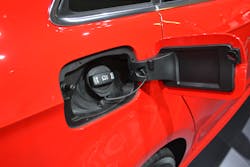University of Extrication: Understanding Electric Vehicle Charging Ports
Topic: Understanding electric vehicle charging ports
Objective: Recognize the role that electric vehicle charging ports play in determining the propulsion system of the vehicle.
Task: The rescue team shall understand the various indicators of a vehicle’s propulsion system with special attention on the role of electric vehicle charging ports.
We reviewed critically important size-up procedures, specifically designed for rescue officers, in the May 2016 University of Extrication column (firehouse.com/12186408). In that article, we encouraged initial-arriving personnel to look for small “doors” on the front, sides, or even along the rear bumper of vehicles as they conduct their walk-around scene size-up activities. The presence of these small doors is a very important new means of determining if the vehicle is an internal combustion engine vehicle, a hybrid, plug-in hybrid, electric plug-in, or an alternate-fueled vehicle, such as a hydrogen fuel cell vehicle.
Small door identification
In this article, we focus on how to better understand what you see when you open a small door on the crash-damaged vehicle.
This is our University of Extrication “Small Door Size-Up Identification Chart.” Use it as a guide in determining what type of vehicle you are dealing with.
Small Door Size-Up Identification Chart
What You See What You Have
Only one small door present with fuel-filler tube Internal combustion engine vehicle (gasoline or diesel) or hybrid vehicle
Only one small door present with electrical charging port Electric vehicle (e.g., Nissan LEAF, Tesla Model S, Model X)
Only one small door present with steel fitting Alternate-fueled vehicle (e.g.,Toyota Mirai Fuel Cell)
Two small doors present on the vehicle Plug-in hybrid (e.g., Toyota Prius Plug-In) or extended-range electric vehicle (e.g., Chevy VOLT)
This rule of thumb guidance presents new information to add to the size-up process for any late-model crash-damaged vehicle. As the rescue officer moves around the vehicle conducting their scene size-up, looking for all the common challenges that might exist, the process should now include determining the vehicle’s propulsion system. This information is especially important to those on scene, especially if the vehicle is powered by something other than the familiar gasoline or diesel fuel.
High-voltage risks
There are several different types of electric vehicle or plug-in hybrid charging port receptacles that one might find when they open one of these small doors and find an electrical receptacle. One charging port design is for 120-volt charging, another design allows charging of the high-voltage battery from a 240-volt source, and still another handles rapid, high-voltage charging using a 440-volt power source.
The reality is that out on the street, it does not matter what type of electrical charging receptacle is discovered when you open the small door. All that matters is that you discovered an electrical charging port of any type, size, capacity or design. Knowing that there is a charging port present tips off on-scene personnel that the vehicle they are dealing with is either a plug-in hybrid or an electric vehicle.
This information also tells responders that somewhere in and throughout the vehicle, there are high voltages present. Very importantly, an electrical charging port also indicates that somewhere on the vehicle, there is at least one high-voltage battery—something that can make a big difference during a rescue or a fire situation.
Once the size-up process locates an electrical charging port of any size, responders should consider initiating their department’s procedures for shutting down the vehicle. This process should include putting the vehicle in park and turning the ignition off. If everything is working as it is designed to function after the crash, these actions should shut down the hybrid or electric vehicle’s high-voltage power. Caution: You still have to deal with the 12-volt electrical power on the vehicle and may have stranded energy present as the capacitors slowly dissipate.
Sidebar
What the Small Door Can Reveal
- Internal combustion engine vehicle
- Hybrid vehicle
- Electric vehicle
- Alternate-fueled vehicle
- Plug-in hybrid
- Extended-range electric vehicle

Ron Moore
RON MOORE, who is a Firehouse contributing editor, recently retired as a division chief with the McKinney, TX, Fire Department and now serves with Prosper, TX, Fire Rescue. He self-published the Vehicle Rescue 1-2-3 training manual and serves as the forum moderator for the extrication section of Firehouse.com . Moore can be contacted directly at [email protected].






